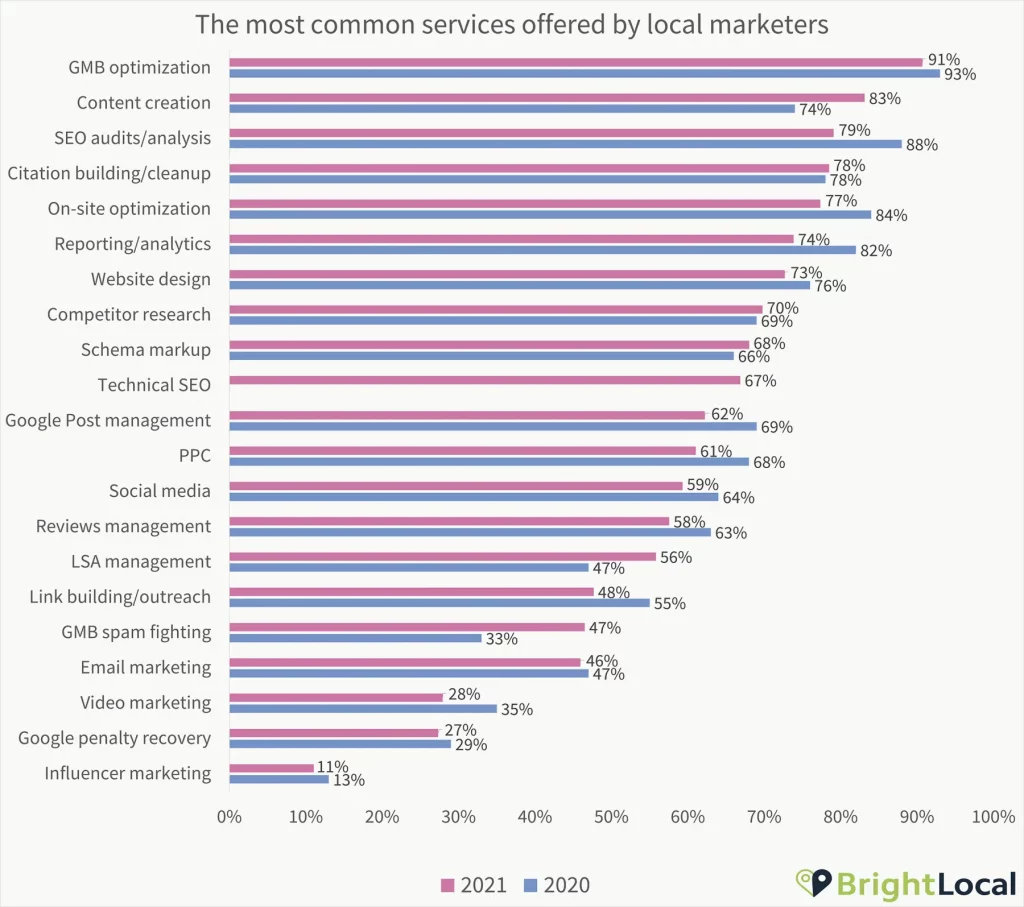In today’s digital world, establishing a robust online presence is vital for the success of any local business. The key to enhancing your visibility in search engine results and attracting local customers lies in effective local SEO. But how can you be certain that your local SEO endeavors are yielding the desired results? The answer lies in performing a meticulous local SEO audit.
Why a Local SEO Audit is Crucial

A local SEO audit empowers you to assess your website’s current state, local listings, content, and backlinks. By conducting a comprehensive audit, you can unearth opportunities to optimize your online presence, ultimately driving more traffic and conversions.
Understanding the importance of a local SEO audit is pivotal:
- Identifying Strengths and Weaknesses: A local SEO audit helps you discern your website’s strong and weak points in terms of structure, content, and more. This knowledge informs your efforts to optimize your online presence.
- Staying Updated with Algorithm Changes: Search engine algorithms are perpetually evolving. Regular audits ensure that your strategies remain aligned with the latest changes, enabling your site to maintain optimal performance in search engine rankings.
- Improving User Experience: A seamless user experience is integral to local SEO. An audit uncovers usability issues, facilitating enhancements that boost user satisfaction and engagement.
- Ensuring Accuracy of Local Listings: Local business listings are essential for attracting local clientele. An audit guarantees that your business information is consistent and accurate across platforms like Google My Business, Yelp, and other directories, contributing to your local search rankings.
- Optimizing Content Relevance: Content significantly influences local SEO. An audit helps assess the relevance and quality of your content concerning local search queries. This, in turn, allows you to refine your content strategy to target local keywords more effectively.
- Identifying Competitor Strategies: A local SEO audit gives you an opportunity to analyze the online presence of your competitors. Understanding their strategies provides insights into what works for them, enabling you to adapt similar approaches for your business.
Strategies Involved in Local SEO Audit:
A. Website Audit:

- Review Website Structure and Navigation:
Start by evaluating the organization and navigation of your website. Ensure that it is user-friendly and easy to navigate. Check for:
- Clear and logical menu structure: Ensure that your website’s menus are well-organized and easy to understand.
- Internal linking: Verify that there are appropriate internal links between related pages.
- Mobile-friendliness: Ensure that your website is responsive and mobile-friendly, as this is a critical factor for both user experience and SEO.
Recommended Tools:
- Google Search Console: Provides insights into site structure and issues.
- Screaming Frog SEO Spider: Helps you analyze your website’s structure and internal linking.
- Assess Website Speed and Performance:
Website speed is a crucial ranking factor, and it significantly impacts user experience. Optimize for performance by:
- Compressing images and other media files to reduce page load times.
- Enabling browser caching to reduce server load.
- Minimizing the use of large JavaScript and CSS files.
- Upgrading your hosting service if necessary to improve server response times.
Recommended Tools:
- Google PageSpeed Insights: Measures page speed and provides suggestions for improvement.
- GTmetrix: Offers detailed performance reports and recommendations.
- Conduct Keyword Research and On-Page Optimization:
Local SEO relies on optimizing your website for relevant keywords. Identify local keywords related to your business or niche and integrate them into your website’s content. This includes:
- Optimizing meta titles, descriptions, and header tags (H1, H2, etc.) with local keywords.
- Creating high-quality, informative, and engaging content that incorporates these keywords naturally.
- Ensuring that your website’s URL structure is clean and includes relevant keywords where appropriate.
Recommended Tools:
- Google Keyword Planner: Helps identify local keywords with search volume.
- SEMrush or Ahrefs: Useful for competitive analysis and tracking keyword rankings.
- Yoast SEO (WordPress) or All in One SEO Pack (WordPress): Plugins for on-page optimization.
- Evaluate Local Schema Markup and Structured Data:
Implementing structured data (Schema markup) can help search engines understand the content and context of your website, making it easier for them to provide accurate search results. Focus on:
- Adding local business schema markup to your website, providing information like your business name, address, phone number, and opening hours.
- Including structured data for relevant services, products, reviews, and other local SEO elements.
Recommended Tools:
- Google’s Structured Data Testing Tool: Validates your schema markup.
- Schema.org Markup Generator: Assists in creating structured data markup.
- Evaluate Website Content and Relevance:
Assess the quality, relevance, and local targeting of your website’s content. This involves:
- Regularly updating and maintaining your content to keep it fresh and accurate.
- Ensuring your content addresses the needs and questions of your local audience.
- Monitoring user engagement metrics (such as bounce rate, time on page) to gauge content quality and relevance.
Recommended Tools:
- Google Analytics: Tracks user engagement and behavior on your website.
- Content management systems (CMS) analytics tools like WordPress Jetpack or HubSpot: Provide content performance insights.
- Surfer SEO: Analyzes content relevance and suggests improvements.
- Analyze User Experience and Conversion Optimization:
A great user experience not only improves SEO but also enhances your website’s ability to convert visitors into customers. Consider the following:
- User-friendly design: Ensure that your website is aesthetically pleasing, easy to navigate, and provides a positive user experience.
- Clear and prominent calls-to-action (CTAs) to guide users towards desired actions, such as contacting you or making a purchase.
- Optimize forms and contact methods to make it easy for visitors to get in touch.
Recommended Tools:
- Heatmap and Session Recording Tools: Tools like Hotjar or Crazy Egg to understand user behavior.
- Google Optimize: Helps you run A/B tests for better user experience.
- OptinMonster: For creating eye-catching CTAs and lead generation forms.
- Local SEO Tools and Tracking:
Utilize SEO tools to monitor the performance of your local SEO efforts. Regularly check rankings, traffic, and conversions to track your progress. Make adjustments based on your findings and stay updated on the latest SEO trends and algorithm updates.
Recommended Tools:
- Google My Business: Essential for local business listings and reviews.
- Moz Local or BrightLocal: Tools for managing local citations and monitoring local SEO performance.
- Google Analytics and Google Search Console: Continued use for tracking website performance and search analytics.
- Rank tracking tools like SEMrush or SERPWatcher to monitor keyword rankings.
B. Local Listing Audit:

Ensuring that your local business listings are accurate and consistent across online directories is vital for local SEO and attracting potential customers. Here’s a step-by-step guide on how to conduct a thorough local listing audit.
- Signs Your Local Listing Needs an Audit:
Before diving into the audit process, it’s essential to identify the red flags that indicate your local listings may need attention. Look out for signs such as:
- Inaccurate business information, including the wrong address, phone number, or business name.
- Inconsistencies in your business details across different directories.
- A decrease in your online visibility and local search rankings.
- Negative customer reviews or outdated information.
2. Tools for Conducting a Local Listing Audit:
To conduct an effective local listing audit, you’ll need the right tools. Here are some recommended tools for this purpose:
- Google My Business: A fundamental tool for managing your business listings on Google.
- Moz Local: Provides insights into the accuracy and consistency of your listings.
- Yext: Helps you manage and optimize your business information across various directories.
- BrightLocal: Offers a comprehensive suite of local SEO tools, including a listing management feature.
3. Correct Process of Auditing Your Local Listings:
To ensure your local business listings are accurate and consistent, follow a systematic approach to conduct the audit:
- Start with Google My Business: Verify that your information is up to date and accurate, including business name, address, phone number, hours of operation, and category.
- Check Major Directories: Use tools like Moz Local, Yext, and BrightLocal to scan major directories and identify inconsistencies or inaccuracies in your listings.
- Verify NAP Consistency: Ensure that your NAP (Name, Address, Phone number) details are consistent across all directories.
- Identify Duplicate Listings: Look for and merge or delete duplicate listings to avoid confusion.
- Update Visuals: Review and update images and logos to maintain a professional appearance.
- Request Customer Reviews: Encourage satisfied customers to leave positive reviews, as they can enhance your local SEO.
4. Optimize Your Local Listings for Better Visibility:
Beyond ensuring accuracy and consistency, you can further optimize your local listings to improve visibility and attract more customers:
- Enhance Business Descriptions: Craft compelling and informative descriptions that reflect your business’s unique selling points.
- Select Relevant Categories: Choose accurate and relevant categories to help potential customers find your business more easily.
- Add High-Quality Visuals: Include high-resolution images that showcase your products, services, and the ambiance of your business.
- Manage Reviews: Respond to customer reviews promptly, both positive and negative, to demonstrate your commitment to customer satisfaction.
- Leverage Google Posts: Use Google Posts: to share updates, events, and promotions to engage with your local audience.
C. Content Audit for Local SEO

Optimizing your website for local search requires content that is not only engaging but also highly relevant to your local audience. Here’s a step-by-step guide on how to conduct a content audit for local SEO:
- Regularly Evaluate your Content for Local Relevance:
Start by identifying content that is specifically tailored to your local audience. This includes blog posts, articles, and landing pages that mention local services, events, or news. To determine the local relevance of your content, consider the following: Does the content target local keywords and phrases?Is the information accurate and up-to-date for your local area? Does the content address the needs and interests of your local audience?
2. Use Tools for Content Analysis:
Employing tools such as Google Analytics can provide valuable insights into how your content is performing. Analyze metrics like page views, bounce rate, and time on page to assess the effectiveness of your content.
Links:
- Google Analytics: A free tool to track website traffic and user behavior.
- Moz: Offers tools and resources for SEO analysis, including content analysis.
3. Store & Organize Your Content Efficiently:
To conduct a successful content audit, you should maintain a well-organized inventory of your content. This inventory should include details such as the content title, URL, publication date, and local keywords used.
Links:
- Content Inventory Template: A template to help you organize your content effectively.
4. Update & Optimize Your Content Regularly:
Outdated content can negatively impact your local SEO efforts. It’s essential to regularly review your content and optimize it with local keywords. Focus on:
- Yoast SEO (WordPress): A WordPress plugin for on-page optimization.
5. Add Local Elements to Your Content:Enhance the local relevance of your content by incorporating elements such as local references, customer testimonials, and location-specific details. This adds authenticity and trustworthiness to your content, which can improve its appeal to local audiences.Links:
- Local Testimonials: A guide on using testimonials in local SEO.
- Local SEO Best Practices: Additional resources for local SEO best practices.
D. Backlink Audit for Local SEO:

Backlinks play a pivotal role in achieving SEO success, especially in the context of local SEO. Here’s a step-by-step guide on how to conduct a backlink audit for local SEO. Begin by grasping the significance of backlinks in the realm of local SEO. Recognize why backlinks are crucial for boosting your local search rankings. These inbound links act as endorsements for your website’s authority and relevance to local searchers.
Links:
- Why Backlinks Matter in Local SEO: A discussion on the significance of backlinks in local SEO.
Tools for Analyzing Backlinks:
To perform a comprehensive backlink audit, you need the right tools at your disposal. Utilize professional tools such as Ahrefs, Moz, or SEMrush to analyze your backlink profile thoroughly. These tools provide insights into your backlinks, their quality, and their impact on your SEO.
Links:
- Ahrefs: A powerful tool for backlink analysis and SEO research.
- Moz: Offers backlink analysis and SEO tools.
- SEMrush: A comprehensive SEO toolset with backlink analysis features.
Process of Conducting a Backlink Audit:
Your backlink audit should be a systematic process that involves the careful examination of your backlink data. Pay attention to the following:
- Assess the quantity and quality of backlinks pointing to your site.
- Identify the sources of these backlinks and the anchor text used.
- Analyze the domain authority and trustworthiness of linking websites.
- Review the context in which these backlinks are placed.
Identifying and Disavowing Harmful Links:
Part of the audit process is the identification and removal of harmful backlinks that may negatively impact your SEO efforts. Harmful links can come from spammy or low-quality sources. In cases where removal is not possible, consider using Google’s Disavow Tool to disavow these links.Links:
- Google Disavow Tool: Google’s official tool for disavowing harmful backlinks.
Building High-Quality Local Backlinks:
While auditing is essential, equally important is proactively building high-quality backlinks to enhance your local SEO. Develop a strategy to acquire local backlinks from reputable sources. This might involve:
- How to Build Quality Backlinks for Local SEO: A guide on building high-quality backlinks for local SEO success.
Conclusion:
In conclusion, grasping the significance of a local SEO audit is a pivotal step toward boosting your local business’s digital triumph. This audit encompasses a comprehensive evaluation of your website, local listings, content, and backlinks, affording you the opportunity to identify areas for enhancement and fine-tune your local SEO strategies.
FAQs On Local SEO Audit:
Why is a local SEO audit important for my business?
A local SEO audit is vital as it enables you to assess the effectiveness of your current strategies, discover areas in need of improvement, and stay up-to-date with search engine algorithm changes. It helps improve user experience, ensures accurate local listings, optimizes content relevance, and provides insights into your competitors’ strategies.
What are the key steps in conducting a local SEO audit?
A comprehensive local SEO audit involves four key steps: website audit, local listing audit, content audit, and backlink audit. Each step addresses a specific aspect of your online presence and is critical to optimizing your local SEO strategy.
How can I optimize my local business listings for better visibility?
To optimize your local business listings, ensure that your business descriptions are compelling and include relevant keywords. Choose accurate categories, add high-quality photos and videos, encourage customer reviews, and utilize Google Posts to engage with potential customers.
What is the significance of local content optimization in a local SEO audit?
Local content optimization ensures that your website’s content is tailored to your local audience, provides valuable information to potential customers, and enhances your visibility in local search results. It involves updating content, optimizing with local keywords, and improving readability.
Why is a backlink audit essential for local SEO?
Backlinks play a significant role in determining your website’s authority and credibility in the eyes of search engines. A backlink audit helps identify low-quality or harmful links, enabling you to disavow them and build a strong and reputable link profile for improved local search rankings.



